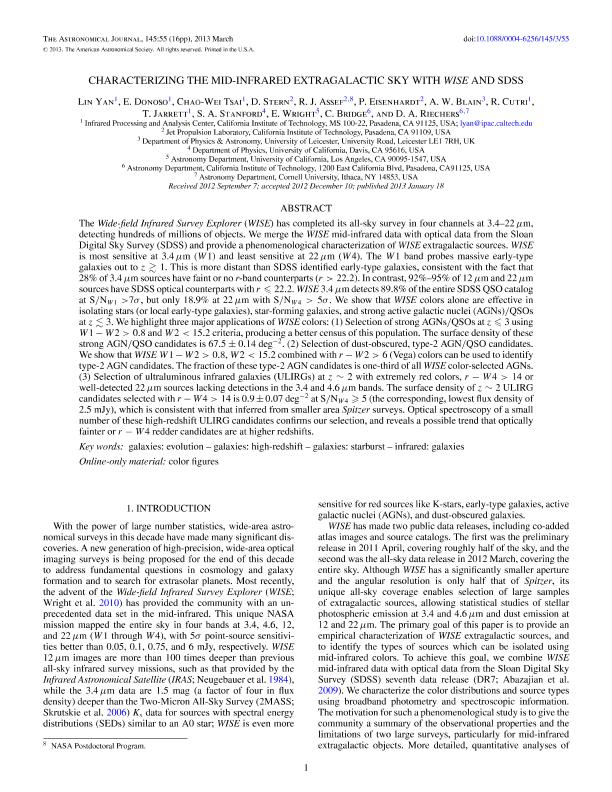Artículo
Characterizing the Mid-infrared Extragalactic Sky with WISE and SDSS
Yan, L.; Donoso, Emilio ; Tsai, Chao Wei; Stern, D.; Assef, R. J.; Eisenhardt, P.; Blain, A. W.; Cutri, R.; Jarrett, T. H.; Stanford, S. A.; Wright, E.; Bridge, C.; Riechers, D. A.
; Tsai, Chao Wei; Stern, D.; Assef, R. J.; Eisenhardt, P.; Blain, A. W.; Cutri, R.; Jarrett, T. H.; Stanford, S. A.; Wright, E.; Bridge, C.; Riechers, D. A.
 ; Tsai, Chao Wei; Stern, D.; Assef, R. J.; Eisenhardt, P.; Blain, A. W.; Cutri, R.; Jarrett, T. H.; Stanford, S. A.; Wright, E.; Bridge, C.; Riechers, D. A.
; Tsai, Chao Wei; Stern, D.; Assef, R. J.; Eisenhardt, P.; Blain, A. W.; Cutri, R.; Jarrett, T. H.; Stanford, S. A.; Wright, E.; Bridge, C.; Riechers, D. A.
Fecha de publicación:
18/03/2013
Editorial:
American Astronomical Society
Revista:
Astronomical Journal
ISSN:
0004-6256
Idioma:
Inglés
Tipo de recurso:
Artículo publicado
Clasificación temática:
Resumen
The Wide-field Infrared Survey Explorer (WISE) has completed its all-sky survey in four channels at 3.4–22um, detecting hundreds of millions of objects. We merge the WISE mid-infrared data with optical data from the Sloan Digital Sky Survey (SDSS) and provide a phenomenological characterization of WISE extragalactic sources. WISE is most sensitive at 3.4um (W1) and least sensitive at 22um (W4). The W1 band probes massive early-type galaxies out to z~1. This is more distant than SDSS identified early-type galaxies, consistent with the fact that 28% of 3.4um sources have faint or no r-band counterparts (r > 22.2). In contrast, 92%–95% of 12um and 22um sources have SDSS optical counterparts with r<22.2. WISE 3.4um detects 89.8% of the entire SDSS QSO catalog at S/N W1 >7σ, but only 18.9% at 22um with S/N W4 > 5 sigma. We show that WISE colors alone are effective in isolating stars (or local early-type galaxies), star-forming galaxies, and strong active galactic nuclei (AGNs)/QSOs at z~3. We highlight three major applications of WISE colors: (1) Selection of strong AGNs/QSOs at z~3 using W1−W2>0.8 and W2<15.2 criteria, producing a better census of this population. The surface density of these strong AGN/QSO candidates is 67.5$pm$0.14 deg^−2 . (2) Selection of dust-obscured, type-2 AGN/QSO candidates. We show that WISE W1−W2>0.8, W2 < 15.2 combined with r−W2>6 (Vega) colors can be used to identify type-2 AGN candidates. The fraction of these type-2 AGN candidates is one-third of all WISE color-selected AGNs. (3) Selection of ultraluminous infrared galaxies (ULIRGs) at z∼2 with extremely red colors, r − W4 > 14 or well-detected 22um sources lacking detections in the 3.4 and 4.6um bands. The surface density of z∼2 ULIRG candidates selected with r −W4 > 14 is 0.9$pm$0.07 deg−2 at S/N W4~5 (the corresponding, lowest flux density of 2.5 mJy), which is consistent with that inferred from smaller area Spitzer surveys. Optical spectroscopy of a small number of these high-redshift ULIRG candidates confirms our selection, and reveals a possible trend that optically fainter or r−W4 redder candidates are at higher redshifts.
Archivos asociados
Licencia
Identificadores
Colecciones
Articulos(ICATE)
Articulos de INST.D/CS ASTRONOMICAS D/LA TIERRA Y DEL ESPACIO
Articulos de INST.D/CS ASTRONOMICAS D/LA TIERRA Y DEL ESPACIO
Citación
Yan, L.; Donoso, Emilio; Tsai, Chao Wei; Stern, D.; Assef, R. J.; et al.; Characterizing the Mid-infrared Extragalactic Sky with WISE and SDSS; American Astronomical Society; Astronomical Journal; 145; 5; 18-3-2013; 1-16
Compartir
Altmétricas



